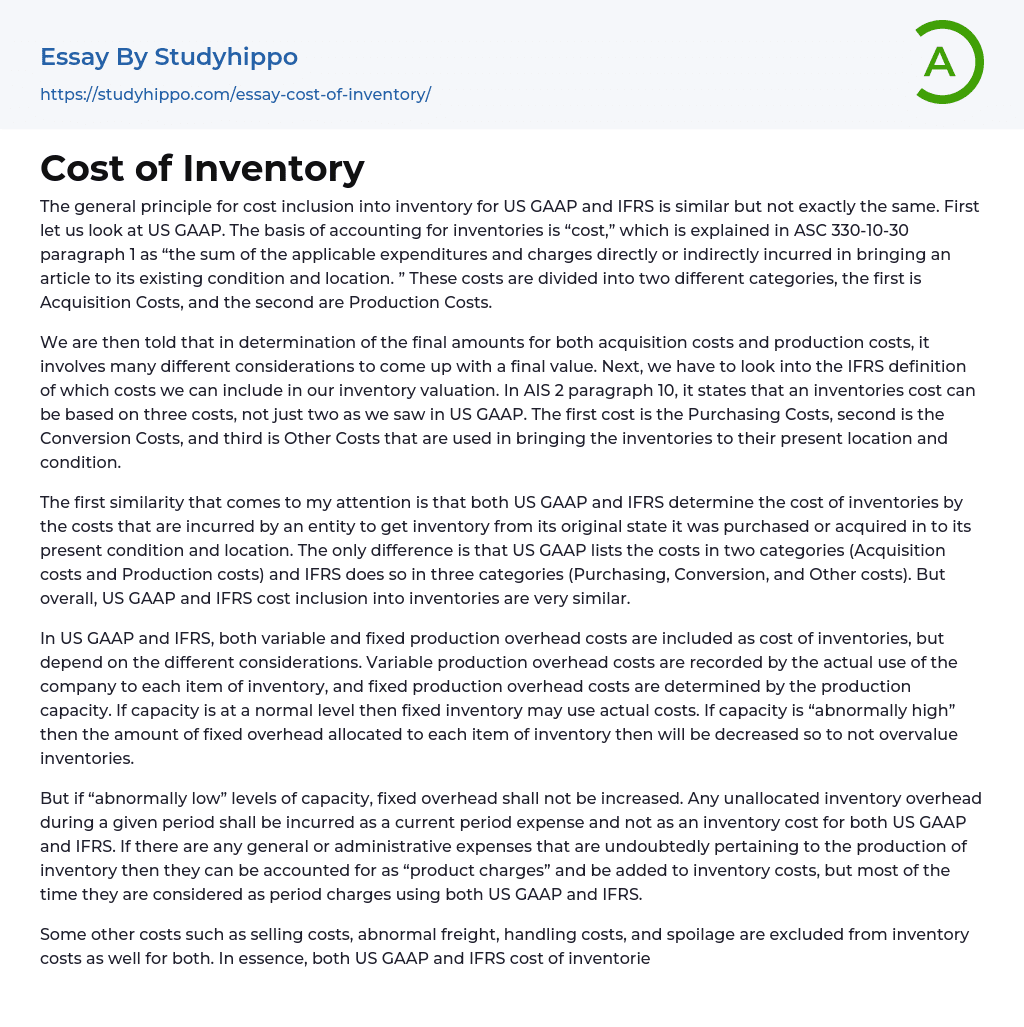The general principle for cost inclusion into inventory for US GAAP and IFRS is similar but not exactly the same. First let us look at US GAAP. The basis of accounting for inventories is “cost,” which is explained in ASC 330-10-30 paragraph 1 as “the sum of the applicable expenditures and charges directly or indirectly incurred in bringing an article to its existing condition and location. ” These costs are divided into two different categories, the first is Acquisition Costs, and the second are Production Costs.
We are then told that in determination of the final amounts for both acquisition costs and production costs, it involves many different considerations to come up with a final value. Next, we have to look into the IFRS definition of which costs we can
...include in our inventory valuation. In AIS 2 paragraph 10, it states that an inventories cost can be based on three costs, not just two as we saw in US GAAP. The first cost is the Purchasing Costs, second is the Conversion Costs, and third is Other Costs that are used in bringing the inventories to their present location and condition.
The first similarity that comes to my attention is that both US GAAP and IFRS determine the cost of inventories by the costs that are incurred by an entity to get inventory from its original state it was purchased or acquired in to its present condition and location. The only difference is that US GAAP lists the costs in two categories (Acquisition costs and Production costs) and IFRS does so in three categories (Purchasing, Conversion, and Other costs). But overall,
US GAAP and IFRS cost inclusion into inventories are very similar.
In US GAAP and IFRS, both variable and fixed production overhead costs are included as cost of inventories, but depend on the different considerations. Variable production overhead costs are recorded by the actual use of the company to each item of inventory, and fixed production overhead costs are determined by the production capacity. If capacity is at a normal level then fixed inventory may use actual costs. If capacity is “abnormally high” then the amount of fixed overhead allocated to each item of inventory then will be decreased so to not overvalue inventories.
But if “abnormally low” levels of capacity, fixed overhead shall not be increased. Any unallocated inventory overhead during a given period shall be incurred as a current period expense and not as an inventory cost for both US GAAP and IFRS. If there are any general or administrative expenses that are undoubtedly pertaining to the production of inventory then they can be accounted for as “product charges” and be added to inventory costs, but most of the time they are considered as period charges using both US GAAP and IFRS.
Some other costs such as selling costs, abnormal freight, handling costs, and spoilage are excluded from inventory costs as well for both. In essence, both US GAAP and IFRS cost of inventories are very similar. The cost inclusion into inventory using US GAAP is more Principle-based. As stated in ASC 330-10-30 paragraph #8, it is critical to practice ethical and sound judgment for every individual circumstance that arises when using the particular cost accounting system within a given
entity.
Another large reason for US GAAP being more principle based is how the company uses its sound principles and how consistent they are using those same principles over the continuous life of the company. I found IFRS to be more rule-based than US GAAP. An example I found interesting is the rule of determining the cost of the purchase of inventories. The rule in IAS 2 paragraph #11 explains that the costs of purchase includes more than a few costs. These costs are the purchase price of inventory, import duties, and other taxes that cannot be recovered from the taxing power, along with transport and handling costs.
This is a lot more thorough of an explanation for the cost of purchasing compared to US GAAP. US GAAP leaves the “acquisition costs” definition more to the principles practices by the company’s accountants. In conclusion, US GAAP and IFRS are both very similar to one another when determining the cost of inventories. US GAAP is more principle-based and leaves the accountant to use his sound judgment and accepted principles with consistency. IFRS is more rule-based and states the definitions for costs to include in inventory more clearly.
- Audit essays
- Budgeting essays
- Cost Accounting essays
- Accountability essays
- Accounting Software essays
- Accounts Receivable essays
- Auditor's Report essays
- Balance Sheet essays
- Cash essays
- Cash Flow essays
- Costs essays
- Financial Audit essays
- Internal Control essays
- International Financial Reporting Standards essays
- Management Accounting essays
- Principal essays
- Tax essays
- Accounting essays
- Andrew Carnegie essays
- Automation essays
- Business Cycle essays
- Business Intelligence essays
- Business Model essays
- Business Operations essays
- Business Software essays
- Cooperation essays
- Cooperative essays
- Corporate Social Responsibility essays
- Corporation essays
- Customer Relationship Management essays
- Family Business essays
- Franchising essays
- Harvard Business School essays
- Harvard university essays
- Human Resource Management essays
- Infrastructure essays
- Inventory essays
- Logistics essays
- Management essays
- Manufacturing essays
- Market essays
- Marketing essays
- Multinational Corporation essays
- News Media essays
- Online Shopping essays
- Quality Assurance essays
- Richard Branson essays
- Sales essays
- Selling essays
- Shopping Mall essays




